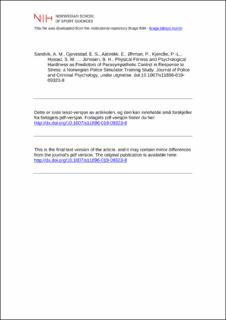| dc.contributor.author | Sandvik, Asle Makoto | |
| dc.contributor.author | Gjevestad, Espen Svendsen | |
| dc.contributor.author | Aabrekk, Einar | |
| dc.contributor.author | Öman, Peter H. | |
| dc.contributor.author | Kjendlie, Per-Ludvik | |
| dc.contributor.author | Hystad, Sigurd William | |
| dc.contributor.author | Bartone, Paul T. | |
| dc.contributor.author | Hansen, Anita Lill | |
| dc.contributor.author | Johnsen, Bjørn Helge | |
| dc.date.accessioned | 2020-03-19T14:28:34Z | |
| dc.date.available | 2020-03-19T14:28:34Z | |
| dc.date.created | 2019-03-28T10:07:31Z | |
| dc.date.issued | 2019 | |
| dc.identifier.citation | Journal of Police and Criminal Psychology. 2019, under utgivelse. | en_US |
| dc.identifier.issn | 0882-0783 | |
| dc.identifier.uri | https://hdl.handle.net/11250/2647627 | |
| dc.description | I Brage finner du siste tekst-versjon av artikkelen, og den kan inneholde ubetydelige forskjeller fra forlagets pdf-versjon. Forlagets pdf-versjon finner du på link.springer.com / In Brage you'll find the final text version of the article, and it may contain insignificant differences from the journal's pdf version. The definitive version is available at link.springer.com | en_US |
| dc.description.abstract | The individual biopsychological response to a specific stressor is the result of a complex interplay between many different factors including physiology, behavior, and personality. The goal of the present study was to explore the potential link between physical fitness, hardiness (Kobasa 1979), and the individual autonomic stress arousal experienced during a stressful police training situation (active shooter). Eighty-four police students participated in the study and were randomly assigned to either a high-stress or a low-stress testing condition. Hardiness was measured with the Dispositional Resilience Scale (Hystad et al. 2010). Physical fitness was assessed with V˙O2max . Parasympathetic control was measured using heart rate variability (HRV), i.e., the root mean square successive difference (RMSSD). Regression analysis showed that psychological hardiness had a negative main effect on change in parasympathetic activity from baseline to the testing phase (B = − 1.43, t = − 2.81, p = 0.007). Larger withdrawal of parasympathetic activation for high-hardy individuals in this phase of the study can be interpreted as an adaptive adjustment to the task set in front of them. A second regression analysis showed that both psychological hardiness (B = − 1.47, t = 3.68, p < 0.001) and physical fitness (B = 0.89, t = 2.85, p = 0.006) had significant main effects on change of parasympathetic activity entering the recovery phase of the study. Both regression coefficients were positive, with higher scores on hardiness and physical fitness predicting greater parasympathetic activation at stress offset. Overall, the results suggest that psychological hardiness and physical fitness may be important factors in how operational stress affects the individual in a police setting. Those high in hardiness and good physical form seem to be better able to recuperate and reset after a stressful incident, something that can be vital in an operational context. These results will be discussed in relation to the existing literature in the field. | en_US |
| dc.language.iso | eng | en_US |
| dc.subject | stress | en_US |
| dc.subject | hardiness | en_US |
| dc.subject | physical fitness | en_US |
| dc.subject | police | en_US |
| dc.subject | parasympathetic control | en_US |
| dc.title | Physical fitness and psychological hardiness as predictors of parasympathetic control in response to stress: a Norwegian police simulator training study | en_US |
| dc.type | Peer reviewed | en_US |
| dc.type | Journal article | en_US |
| dc.description.version | acceptedVersion | en_US |
| dc.source.pagenumber | 1-14 | en_US |
| dc.source.journal | Journal of Police and Criminal Psychology | en_US |
| dc.identifier.doi | 10.1007/s11896-019-09323-8 | |
| dc.identifier.cristin | 1688450 | |
| dc.description.localcode | Seksjon for fysisk prestasjonsevne / Department of Physical Performance | en_US |
| cristin.ispublished | true | |
| cristin.fulltext | postprint | |
| cristin.fulltext | postprint | |
| cristin.qualitycode | 1 | |
